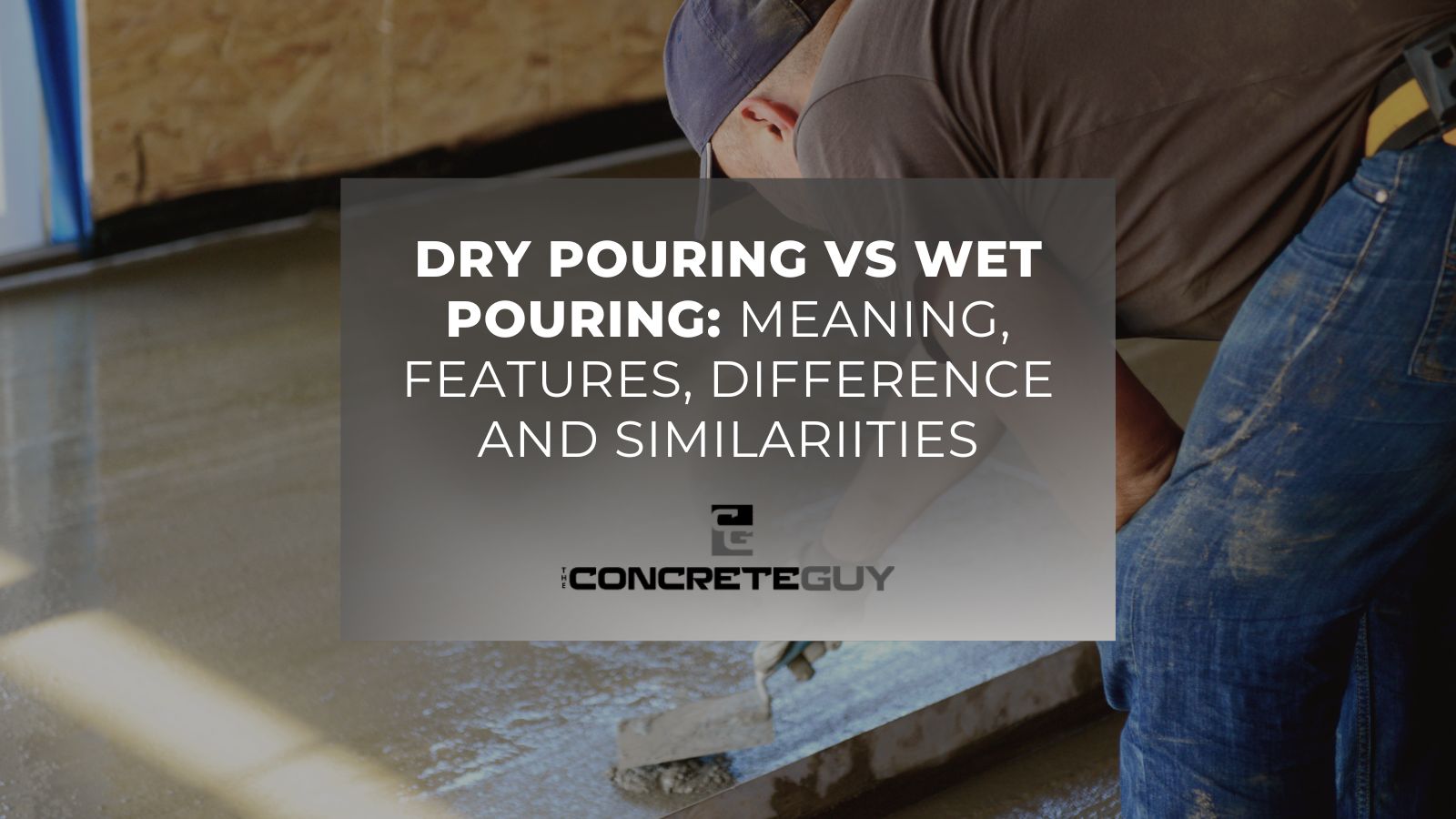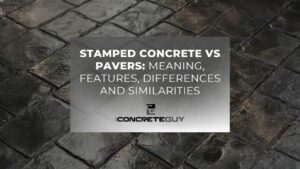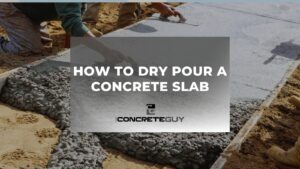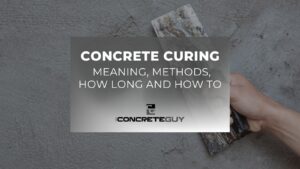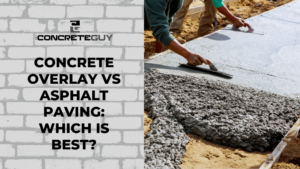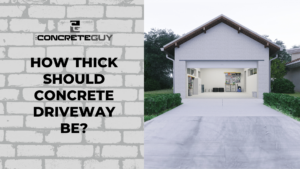Dry pouring, also known as the dry-mix or gunite process, involves mixing dry ingredients such as cement, sand, and aggregates on-site and then pneumatically projecting the mixture onto a surface using compressed air.
Wet pouring, also known as ready-mix or shotcrete process, involves pre-mixing concrete ingredients, including cement, sand, aggregates, and water, at a central plant or batching facility.
The features of dry pouring are flexibility in mix design adjustments and on-site modifications, making it suitable for various applications and challenging construction conditions. It also results in reduced rebound, minimizing material waste and cleanup requirements. Whilst wet pouring delivers consistent concrete quality and properties through controlled batching and mixing processes, ensuring uniform strength, durability, and workability. It facilitates higher placement rates, suitable for large-scale projects and high-volume applications.
Dry pouring involves mixing dry ingredients on-site and projecting them onto a surface using compressed air, while wet pouring involves pre-mixing concrete ingredients at a central plant and transporting the wet concrete mixture to the construction site. Both methods result in durable concrete surfaces but differ in their mixing and placement processes.
What Is Dry Pouring?
Dry pouring, also known as dry-mix concrete, involves getting all the dry materials in bags and then adding water directly to the site through a delivery hose. This method is often used for small to medium-sized projects that need a finer application of concrete, as workers have more control over where the concrete goes. Nevertheless, dry pouring does not saturate all the cement particles and doesn’t provide proper hydration, which affects the strength and durability of the concrete.
What Are the Features of Dry Pouring?
Dry pouring offers several features and benefits that make it a preferred procedure in certain construction scenarios. Here are the key features of dry pouring:
- Controlled Mixing: Dry pouring involves pre-mixing dry concrete ingredients, including cement, aggregates, and additives, to achieve a consistent and controlled mix. This ensures uniformity in the strength, durability, and performance of the concrete.
- Reduced Water Content: Compared to traditional wet mixing methods, dry pouring typically requires less water in the mix. This lower water content contributes to enhanced strength and durability of the cured concrete, as excess water weakens the concrete structure and increases the risk of cracking.
- Customizable Mix Designs: Dry mix concrete allows for greater flexibility in adjusting mix designs to meet specific project requirements. Contractors tailor the mix by varying the proportions of cement, aggregates, additives, and water-reducing agents to achieve the desired strength, workability, and setting time.
- Improved Workability: Dry mix concrete is designed for optimal workability, allowing for easier placement, compaction, and finishing during construction. Properly designed dry mixes result in a smooth and uniform concrete surface without segregation or excessive bleeding.
- Reduced Labor and Equipment Requirements: Dry pouring cuts labor and equipment requirements compared to wet mixing methods. With pre-mixed dry concrete, there is no need for on-site batching plants or continuous mixing, leading to cost savings and increased efficiency.
- Minimal Environmental Impact: Dry mix concrete production generates less waste and consumes less water compared to wet mixing methods, making it a more environmentally sustainable option. The reduced water usage also contributes to lower carbon emissions associated with concrete production.
- Fast Setting and Cure Times: Dry mix concrete is formulated for rapid setting and curing, allowing for accelerated construction schedules and faster project completion. This feature is particularly advantageous in time-sensitive projects or when early strength development is required.
- Suitable for Various Applications: Dry pouring is suitable for a wide range of concrete applications, including foundations, slabs, pavements, structural elements, and precast components. It is used in residential, commercial, industrial, and infrastructure projects with varying design requirements.
- Quality Control: Dry mix concrete production allows for stringent quality control measures to be implemented throughout the manufacturing process. Quality checks are conducted on raw materials, mix proportions, and finished products to ensure consistency and adherence to specifications.
What is Wet Pouring?
Wet pouring is mixing all the materials, including water, at a central location before transporting the mixture to the construction site. This method is often used for larger projects, as it requires more space for the concrete truck to enter and deliver the concrete material. Wet pouring allows for easier and faster application, as the concrete is already mixed and ready to use.
What Are the Features of Wet Pouring?
Wet pouring is a traditional method of concrete placement that involves mixing concrete ingredients with water on-site before pouring it into the formwork. Here are the key features of wet pouring:
- On-Site Mixing: Wet pouring involves the mixing of concrete ingredients, including cement, aggregates, water, and additives, on-site using concrete mixers or batching plants. This allows for the immediate placement of freshly mixed concrete into formwork.
- Adjustable Water Content: Wet mix concrete allows for adjustments in water content to achieve the desired workability, slump, and consistency of the concrete. The water-to-cement ratio is modified based on project requirements and environmental conditions.
- High Workability: Wet mix concrete typically has higher workability compared to dry mix concrete, making it easier to place, compact, and finish. The fluidity of wet concrete allows for better flow around reinforcement, corners, and complex formwork shapes.
- Suitable for Large Volume Projects: Wet pouring is well-suited for large-volume concrete projects such as foundations, slabs, columns, beams, and structural elements. It facilitates the efficient placement of concrete over expansive areas and allows for continuous pouring without interruptions.
- Consistent Quality: Wet mix concrete ensures consistent quality and uniformity throughout the concrete mix, resulting in uniform strength, durability, and performance properties in the cured concrete. Quality control measures are implemented during mixing and placement to maintain standards.
- Extended Workability Time: Wet mix concrete offers extended workability time, allowing for sufficient time for placement, consolidation, and finishing operations. This feature is beneficial in projects that require intricate detailing or adjustments during concrete placement.
- Adaptable to Various Applications: Wet pouring is versatile and adaptable to a wide range of concrete applications, including residential, commercial, industrial, and infrastructure projects. It is utilized for different types of concrete finishes, including smooth, textured, exposed aggregate, and decorative finishes.
- Proper Compaction: Wet mix concrete facilitates proper compaction through vibration or tamping to remove air voids and ensure dense, homogenous concrete. Adequate compaction improves the strength, durability, and long-term performance of the cured concrete.
- Administered Setting Time: Wet mix concrete allows for controlled setting time-based on the type of cement, admixtures, and environmental conditions. Rapid-setting or slow-setting concrete mixes are produced to meet project requirements.
- Requires On-Site Equipment: Wet pouring requires access to concrete mixers, batching plants, and concrete delivery vehicles for on-site mixing and transportation. Proper coordination and scheduling of equipment are essential for efficient concrete placement.
What Are the Differences and Similarities Between Dry Pouring and Wet Pouring?
The difference between dry pouring and wet pouring includes the mixing process, water content, workability, equipment dependency, etc. The similarities between dry pouring and wet pouring include concrete ingredient, versatility, quality control, safety consideration and suitability for precast application.
What are the differences between dry pouring and wet pouring?
1. Mixing Process:
- Dry Pouring: Comprises pre-mixing dry concrete ingredients (cement, aggregates, additives) before adding water on-site.
- Wet Pouring: Requires on-site mixing of concrete ingredients (cement, aggregates, water, additives) to create a wet concrete mix.
2. Water Content:
- Dry Pouring: Uses less water in the mix, resulting in a lower water-to-cement ratio and reduced shrinkage.
- Wet Pouring: Requires more water in the mix for proper workability, leading to a higher water-to-cement ratio and potential for increased shrinkage.
3. Workability:
- Dry Pouring: Typically has lower initial workability, requiring additional effort for placement and compaction.
- Wet Pouring: Offers excellent workability, making it easier to place, compact, and finish the concrete.
4. Equipment Dependency:
- Dry Pouring: Relies on specialized equipment for pre-mixing dry ingredients, transportation, and placement.
- Wet Pouring: Requires concrete mixers, batching plants, and delivery vehicles for on-site mixing and continuous batching.
5. Environmental Impact:
- Dry Pouring: Generates less waste, consumes less water, and reduces carbon emissions compared to wet mix concrete.
- Wet Pouring: Consumes more water, initiates more waste, and has a higher environmental impact due to water usage and waste generation.
6. Setting Time:
- Dry Pouring: It is formulated for rapid setting and curing, allowing for faster construction schedules.
- Wet Pouring: Provides extended workability time but has longer setting and curing times depending on mix design and environmental conditions.
What are the Similarities Between Dry Pouring and Wet Pouring?
- Concrete Ingredients: Dry pouring and wet pouring use the same basic ingredients for concrete, including cement, aggregates (such as sand and gravel), water, and optional additives (such as admixtures or accelerators).
- Versatility: These methods are versatile and suitable for various concrete applications, including foundations, slabs, columns, beams, and structural elements.
- Quality Control: Dry pouring and wet pouring allow for quality control measures during mixing, placement, and curing to ensure consistent quality and performance of the cured concrete.
- Suitability for Precast Applications: Both methods are used in precast concrete applications, where controlled mix designs, fast curing times, and precise placement are important.
- Construction Applications: Both dry pouring and wet pouring are commonly used in residential, commercial, industrial, and infrastructure projects for different types of concrete finishes and structures.
- Safety Considerations: Both methods require adherence to safety protocols, including proper handling of concrete ingredients, equipment operation, and personal protective equipment (PPE) for workers.
While dry pouring and wet pouring have distinct differences in terms of mixing process, water content, workability, equipment dependency, environmental impact, and setting time, they share similarities in terms of concrete ingredients, versatility, quality control, suitability for precast applications, construction applications, and safety considerations. The choice between dry pouring and wet pouring depends on project requirements, desired concrete properties, environmental considerations, and available resources.
What Are the Advantages and Disadvantages of Dry Pouring and Wet Pouring?
Here’s a comparison of the advantages and disadvantages of dry pouring (dry mix concrete placement) and wet pouring (wet mix concrete placement):
Advantages of Dry Pouring (Dry Mix Concrete Placement):
- Controlled Mixing: Dry pouring allows for the pre-mixing of concrete ingredients in controlled conditions, ensuring uniformity and consistency in the mix.
- Reduced Water Content: Dry mix concrete typically requires less water, leading to enhanced strength, durability, and reduced shrinkage.
- Customizable Mix Designs: Dry mix concrete offers flexibility in adjusting mix designs to meet specific project requirements, such as strength, workability, and setting time.
- Lower Labor and Equipment Costs: Dry pouring diminishes labor and equipment costs as it eliminates the need for on-site mixing and continuous batching.
- Environmentally Friendly: Dry mix concrete production generates less waste and consumes less water, making it a more sustainable option.
- Fast Setting and Cure Times: Dry mix concrete for rapid setting and curing allows for faster construction schedules.
- Minimal Environmental Impact: Dry pouring reduces water consumption, waste generation, and carbon emissions compared to wet mix concrete.
- Suitable for Precast Applications: Dry mix concrete is often used in precast concrete applications, where controlled mix designs and fast curing times are advantageous.
Disadvantages of Dry Pouring (Dry Mix Concrete Placement):
- Limited Workability: Dry mix concrete has diminished initial workability compared to wet mix concrete, requiring additional effort for placement and compaction.
- Equipment Dependency: Dry pouring relies on specialized equipment for mixing, transportation, and placement, which needs investment and maintenance.
- Less Time for Adjustment: Once mixed, dry-mixed concrete has limited time for adjustments or modifications before it begins to set, requiring efficient coordination during placement.
- Potential Dust Generation: Dry mixing processes generate dust, requiring dust control measures and proper ventilation to minimize exposure.
Advantages of Wet Pouring (Wet Mix Concrete Placement):
- High Workability: Wet mix concrete offers excellent workability, allowing for easy placement, compaction, and finishing.
- Adaptable to Various Applications: Wet pouring is versatile and suitable for a wide range of concrete applications, including big projects.
- Consistent Quality: Wet mix concrete ensures consistent quality and uniformity throughout the mix, leading to predictable strength and durability in the cured concrete.
- Extended Workability Time: Wet mix concrete provides extended workability time, allowing for adjustments, detailing, and modifications during placement.
- Proper Compaction: Wet mix concrete facilitates proper compaction, ensuring dense, homogenous concrete with reduced air voids.
- Controlled Setting Time: Wet mix concrete allows for controlled setting time predicated on project requirements, cement types, and environmental conditions.
Disadvantages of Wet Pouring (Wet Mix Concrete Placement):
- Higher Water Content: Wet mix concrete typically requires more water, which leads to increased shrinkage, reduced strength, and longer curing times.
- Environmental Impact: Wet mix concrete production consumes more water and develops more waste compared to dry mix concrete, impacting the environment.
- Potential for Segregation: Improper handling or transportation of wet mix concrete causes segregation, affecting the uniformity and quality of the concrete.
- Increased Labor and Equipment Costs: Wet pouring has increased labor and equipment for on-site mixing, transportation, and continuous batching.
What factors do I consider when deciding between dry and wet concrete placement methods?
When choosing between dry and wet concrete placement methods, consider factors such as project timeline, desired concrete properties (such as strength and workability), environmental impact, equipment availability, and cost considerations.
How does the water-to-cement ratio differ between dry and wet concrete placement methods?
Dry concrete placement typically uses a lower water-to-cement ratio compared to wet placement. This results in reduced shrinkage, enhanced strength, and improved durability in the cured concrete. Wet placement, on the other hand, requires more water for workability, causing higher shrinkage and longer curing times.
Are dry and wet concrete placement methods used for precast applications?
Yes, both dry and wet concrete placement methods are utilized for precast applications. Dry pouring is often preferred for precast elements that require rapid setting and controlled mix designs, while wet pouring offers high workability and extended workability time for intricate precast designs.
How does equipment dependency differ between dry and wet concrete placement methods?
Dry concrete placement relies on specialized equipment for pre-mixing dry ingredients and transportation, while wet concrete placement requires concrete mixers, batching plants, and delivery vehicles for on-site mixing and continuous batching. Consider the availability and cost of equipment when deciding on the placement method.
What are the sustainability benefits of dry concrete placement compared to wet placement?
Dry concrete placement offers sustainability benefits such as reduced water consumption, lower carbon emissions, and less waste generation compared to wet placement. The controlled mixing process and lower water content contribute to environmental sustainability in construction projects.
How does workability differ between dry and wet concrete placement methods?
Wet concrete placement typically offers higher initial workability, making it easier to place, compact, and finish. Dry concrete placement lessens initial workability but it is adjusted for optimal workability based on project requirements and mix designs.

